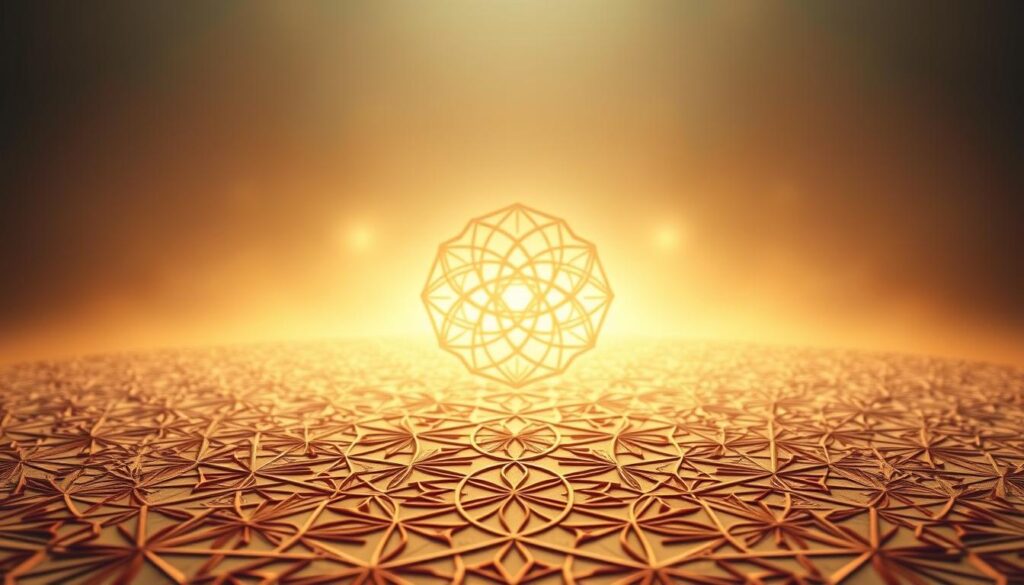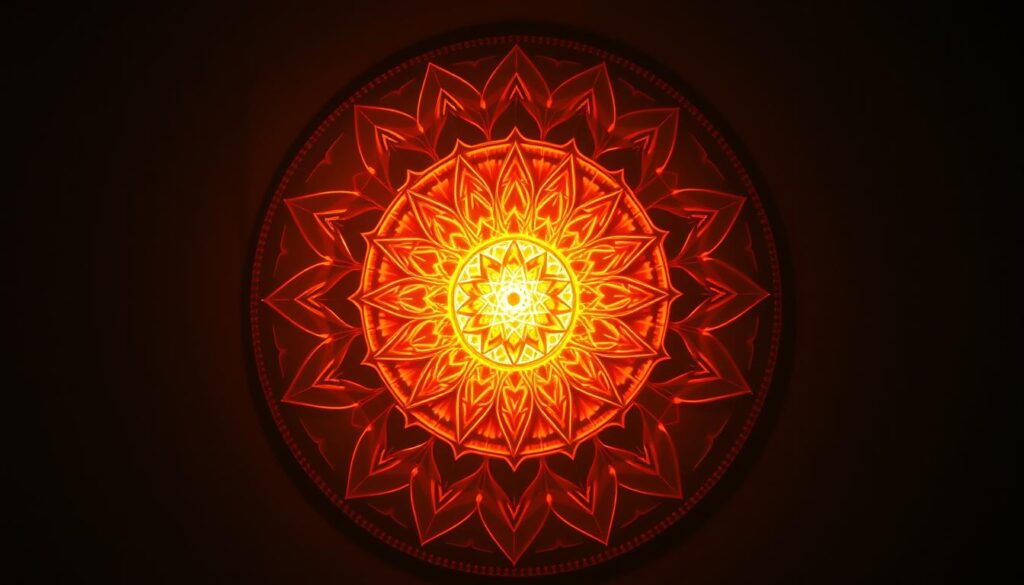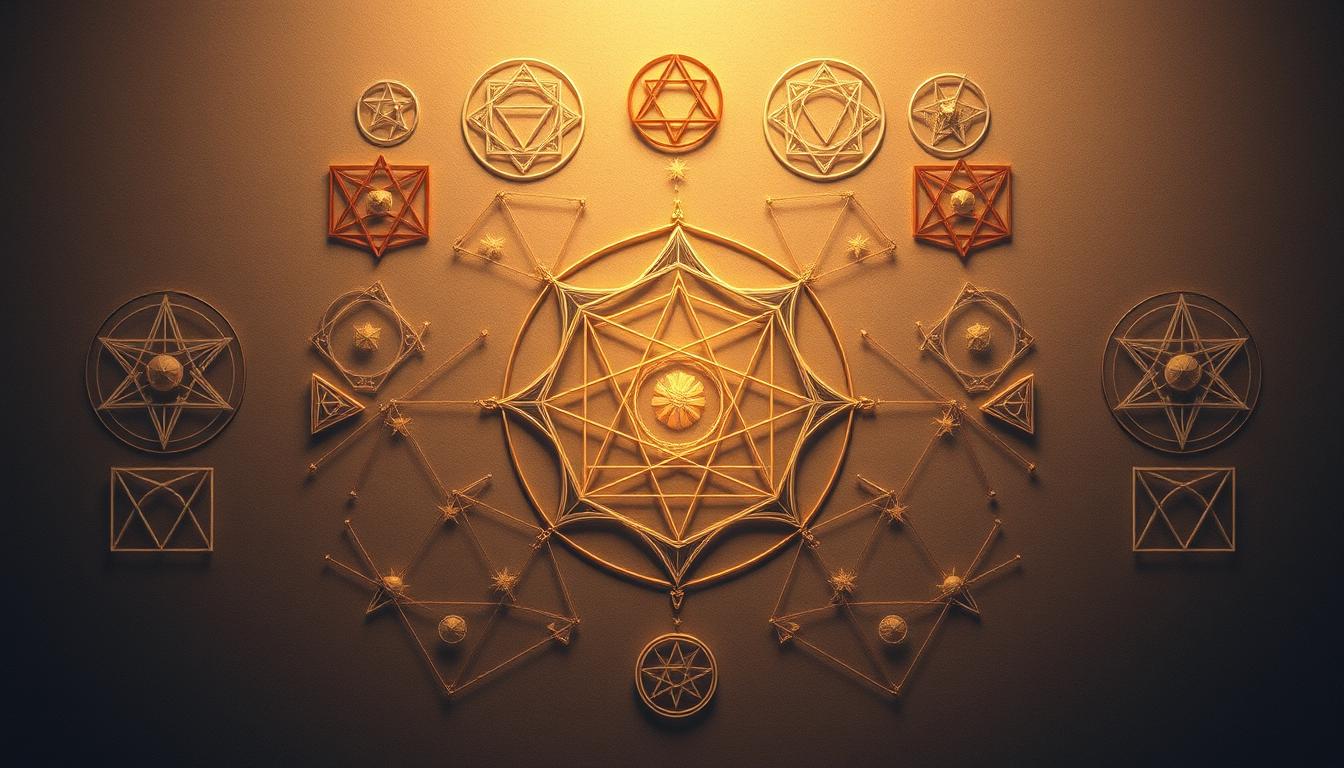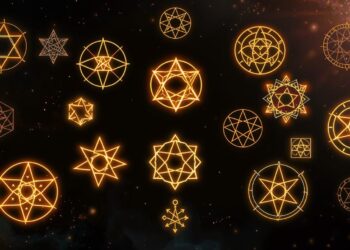“Geometry will draw the soul toward truth,” Plato once declared. This timeless wisdom hints at the profound relationship between universal patterns and human consciousness—a connection that still shapes how we understand art, science, and self-transformation today.
Ancient cultures recognized that certain designs act as bridges between visible and invisible worlds. From the pyramids of Giza to the spirals of galaxies, these shapes appear in nature, architecture, and art as silent messengers of unity. Modern research now confirms what mystics have long known: these forms influence energy fields and subconscious thought patterns.
Consider the Flower of Life—a pattern found in Egyptian temples and modern meditation practices. Its overlapping circles create a blueprint for creation, mirroring cellular growth and cosmic expansion. Similarly, the Vesica Piscis appears in everything from Gothic cathedrals to corporate logos, embedding mathematical precision into daily life.
By understanding these universal codes, you gain tools to reshape personal reality. Architects use them to craft harmonious spaces, while healers apply their vibrational qualities. When aligned with these principles, your mind can unlock creative potential and foster profound growth.
Key Takeaways
- Universal patterns connect spiritual concepts with scientific principles
- Ancient structures like the Parthenon demonstrate intentional design relationships
- Natural forms from cells to galaxies follow mathematical blueprints
- Modern brands use these shapes to influence perception subconsciously
- Conscious engagement with these forms can accelerate personal transformation
The Timeless Journey of Sacred Geometry
Hidden codes of existence reveal themselves through shapes that repeat across eras and continents. These forms served as silent languages for early builders and thinkers, encoding principles of balance found in stars and seashells alike.

Ancient architects wove these designs into their greatest works. The Tree of Life appears in Kabbalistic teachings and Yoruba art, mapping connections between earthly and divine realms. Islamic artists crafted infinite mosaics using star polygons – a nod to creation’s unending complexity.
Three key principles emerge:
- Precision: The Parthenon’s columns follow the Golden Ratio – the same proportion seen in hurricane spirals
- Continuity: Mayan temples mirror celestial alignments still studied by astronomers today
- Adaptation: Modern architects like Zaha Hadid use fluid curves inspired by natural growth patterns
These forms persist because they feel true. Your eye recognizes the harmony in a nautilus shell’s chambers or a sunflower’s seed arrangement. This subconscious resonance explains why brands use circular logos to convey unity and triangles to suggest stability.
From Gothic rose windows to AI-generated art, the journey continues. Apps now turn meditation practices into geometric visualizations, proving these age-old patterns still shape how we interpret reality.
Unlocking the Power of Sacred Geometry Symbols
Certain forms transcend cultural boundaries, speaking a silent language of creation. These visual keys merge artistic expression with mathematical truth—a fusion that shaped Gothic cathedrals and quantum physics diagrams alike. Their precision creates resonance, activating both logical analysis and intuitive recognition.

Leonardo da Vinci’s Vitruvian Man demonstrates this duality. His iconic drawing combines human anatomy with the Golden Ratio—the same proportion found in spiral galaxies. Architects still use this ratio today, proving its timeless relevance.
Three core elements define these designs:
| Form | Structure | Modern Use |
|---|---|---|
| Vesica Piscis | Two overlapping circles | Corporate logos conveying unity |
| Seed of Life | Seven interconnected circles | Meditation apps for focus |
| Metatron’s Cube | 13 interconnected spheres | 3D modeling software frameworks |
Religious art reveals their hidden roles. Stained-glass windows in Chartres Cathedral use hexagrams to symbolize divine harmony. Tibetan mandalas employ concentric squares to map spiritual journeys.
These patterns work because they mirror nature’s blueprints. Honeycombs show hexagonal efficiency, while pinecones display Fibonacci sequences. When you engage with these forms—whether through art or architecture—you align with universal principles that shape reality itself.
The Role of Geometry in Subconscious Programming
Universal patterns act as silent architects of human perception. Their precise structure creates frameworks that shape how we interpret reality, from the symmetry of snowflakes to the spirals of DNA. Research shows these forms bypass conscious analysis, directly influencing neural pathways linked to memory and emotion.

Circles dominate this hidden language. Their endless curves appear in ancient stone circles and modern meditation apps, creating energetic flows that promote focus. The intersection of two circles—known as the Vesica Piscis—holds mathematical precision (√3 proportions) used in Gothic cathedrals and smartphone logos alike.
| Form | Mathematical Basis | Application |
|---|---|---|
| Vesica Piscis | √3 ratio | Architectural arches, spiritual art |
| Seed of Life | Hexagonal symmetry | Sound healing instruments |
| Golden Ratio | 1:1.618 proportion | Product design, facial aesthetics |
Ancient builders intuitively harnessed these principles. Stonehenge’s trilithons mirror celestial alignments, while Egyptian temples used grid systems based on body measurements. These designs didn’t just create spaces—they engineered states of awareness.
Today, engaging with these patterns through mind reprogramming techniques can recalibrate personal energy fields. Whether sketching mandalas or arranging furniture using sacred ratios, you activate a bridge between measurable science and felt experience.
Exploring Key Sacred Shapes
Two overlapping circles hold more power than meets the eye. These ancient designs act as visual bridges between mathematical truth and spiritual insight—tools for decoding universal principles.
The Vesica Piscis and Its Duality
The Vesica Piscis emerges where two circles intersect. This almond-shaped space represents the union of opposites—light and dark, masculine and feminine. Early Christians used it in fish symbols, while Gothic architects built arches using its √3 proportions.
Master builders applied this form strategically:
- Chartres Cathedral’s rose windows frame divine light through its shape
- Modern logos use it to suggest partnership and balance
- Healers employ it in energy work to harmonize dualities
The Seed of Life as a Blueprint
Seven interconnected circles form the Seed of Life, mirroring cellular division and cosmic expansion. Ancient texts link it to the seven days of creation, while meditation practices use it to map consciousness growth.
| Form | Key Feature | Modern Application |
|---|---|---|
| Vesica Piscis | Dualistic harmony | Relationship therapy tools |
| Seed of Life | Generative patterns | 3D printed jewelry designs |
These shapes validate ancient science through their enduring relevance. Whether etched in Egyptian temples or rendered in VR simulations, they continue guiding humanity’s understanding of life’s interconnected patterns.
Decoding the Flower of Life and Its Derivatives
What if a single design held the blueprint for existence? The Flower of Life appears in Egyptian temples, Chinese temples, and medieval manuscripts, forming a universal language of interconnectedness. Its overlapping circles create a hexagonal symmetry found in snowflakes and beehives—nature’s own architectural plans.
Understanding the Fruit of Life Pattern
Within the Flower lies the Fruit of Life—13 interlocking circles forming a star tetrahedron. This pattern maps molecular bonds and galaxy clusters, mirroring how atoms arrange in crystals. Ancient mystics saw it as a map of creation, while physicists now study its role in quantum field theories.
Metatron Cube: The Geometric Codex of the Universe
Derived from the Fruit of Life, the Metatron Cube contains every geometric form found in nature. Its lines reveal the Platonic solids—shapes governing mineral structures and energy flows. Modern applications include:
- 3D modeling software frameworks based on its angles
- Meditation tools using its grid to focus intention
- Architectural designs optimizing spatial harmony
These designs bridge spiritual concepts with material science. Apps transform the Flower of Life into dynamic mandalas for stress reduction, while engineers apply its ratios to sustainable city planning. As you engage with these patterns, you align with the same principles that shape stars and cells—a reminder that growth follows universal blueprints.
The Symbolic Science: Bridging Math and Spirituality
Numbers whisper truths that transcend eras. From seashell spirals to star clusters, precise ratios govern creation’s rhythm. This invisible framework connects quantum physics with spiritual traditions through shapes that balance logic and wonder.
Mathematical Proportions in Harmonious Design
The Golden Ratio (1:1.618) appears in Renaissance art and smartphone screens. Builders of the Parthenon used this proportion to create columns that feel perfectly balanced. Modern studies show brains process these ratios faster, explaining why certain logos and buildings feel instinctively “right.”
Three foundational principles emerge:
- Symmetry: Snowflakes and spiderwebs follow hexagonal patterns for structural efficiency
- Recurrence: Fibonacci sequences guide plant growth and galaxy formations
- Duality: Vesica Piscis intersections (√3 ratio) appear in Gothic arches and DNA helixes
Where Art Meets Quantum Reality
Leonardo da Vinci’s notebooks reveal circles within squares—a dance of finite and infinite. Today, apps transform meditation practices into evolving mandalas using real-time fractal math. This fusion demonstrates how ancient wisdom and modern science both seek patterns that mirror consciousness itself.
Consider these convergences:
| Field | Application | Impact |
|---|---|---|
| Architecture | Golden Ratio grids | Spaces that reduce stress |
| Technology | AI-generated art | New creative dimensions |
| Healing Arts | Sound frequency geometry | Energy field alignment |
When you sketch a spiral or arrange furniture using these ratios, you engage with universal blueprints. This practice bridges personal growth with cosmic order—one calculated curve at a time.
Cultural Perspectives on Sacred Symbols
Civilizations worldwide have embedded universal designs into their greatest achievements. These patterns appear in temples, textiles, and tools—bridging human creativity with cosmic order. Their shared presence across continents suggests a collective understanding of existence’s hidden framework.
Architectural Echoes of Shared Wisdom
Egyptian pyramid corridors align with star constellations, mirroring celestial pathways. Mayan step pyramids encode astronomical cycles in their stair counts. Gothic cathedrals used rose windows with twelve petals—a number symbolizing cosmic completeness in multiple traditions.
Three cultural expressions stand out:
| Culture | Design | Purpose |
|---|---|---|
| Egyptian | Hieroglyphic grids | Aligning body with cosmic energy |
| Chinese | Yin-Yang mosaics | Visualizing unity in duality |
| Native American | Medicine wheels | Mapping nature’s cycles |
These forms do more than decorate—they activate. The Tree of Life appears in both Kabbalistic texts and West African art, teaching interconnectedness through branching patterns. When you study these designs, you join a 5,000-year conversation about humanity’s place in creation.
Traditions preserved this wisdom through precise craftsmanship. Stonemasons carved Celtic knots to represent eternal bonds, while Navajo weavers encoded spiritual maps in rugs. Today, understanding these connections helps us see nature not as separate elements, but as a patterned whole waiting to be decoded.
Modern Applications of Sacred Geometry in Daily Life
How do age-old patterns shape our modern world? From skyscrapers to smartphone interfaces, timeless designs influence how we live, work, and connect. These universal principles now power innovations that blend ancient wisdom with cutting-edge technology.
Creative industries harness these forms to craft memorable experiences. Brands like Amerukhan Basics Clothing weave intricate patterns into fabrics, merging artistic heritage with contemporary style. Architects design buildings using ratios found in sunflowers and hurricanes—creating spaces that feel instinctively harmonious.
Wellness practices also tap into this energy. Meditation apps transform mathematical sequences into pulsating visuals that calm minds. Interior designers arrange furniture using spiral layouts inspired by nautilus shells, fostering balance in homes and offices.
Nature remains the ultimate teacher. The Golden Ratio guides sustainable city planning, while hexagonal patterns improve solar panel efficiency. Even urban parks mimic the branching shapes of rivers and trees, strengthening our connection to Earth’s rhythms.
These applications prove traditions aren’t relics—they’re living tools. By aligning with these principles, you unlock creative potential and cultivate environments where both people and ideas thrive. The same patterns that shaped temples now help build a better tomorrow.
Harmonizing Energy Through Sacred Patterns
Energy flows through life in patterns older than language itself. These dynamic shapes organize everything from cellular communication to planetary magnetic fields. By understanding their rhythms, you can align personal vibrations with universal currents.
The Dynamic Flow of the Torus
The torus resembles a spinning doughnut where energy moves inward, expands outward, and loops back endlessly. This self-sustaining field appears in:
- Atomic structures and hurricane formations
- Human heart’s electromagnetic emissions
- Galactic spirals and fruit growth patterns
Its continuous cycle creates natural balance—a blueprint for sustainable energy systems. Architects now use toroidal layouts in eco-homes, while sound healers apply its principles to frequency therapy.
Merkaba: The Chariot of Light and Transformation
Two interlocking tetrahedrons form the Merkaba—a multidimensional symbol known as the “light vehicle.” This star-shaped design rotates in opposite directions, generating a protective energy matrix. Modern applications include:
| Field | Use | Impact |
|---|---|---|
| Meditation | Visualization tool | Mental clarity |
| Interior Design | Space harmonization | Stress reduction |
| Energy Healing | Chakra alignment | Emotional release |
When combined with the torus’ flow, these patterns help recalibrate physical and spiritual connections. Apps now simulate their rotations for guided mindfulness sessions, proving ancient wisdom fuels modern breakthroughs.
Integrating Sacred Geometry into Daily Meditation
Transformative practices often begin with focused attention—a principle validated by both ancient traditions and modern neuroscience. By anchoring awareness in precise visual designs, you create pathways for balancing energy and expanding awareness.
Practical Techniques for Energy Alignment
Start by selecting a pattern that resonates with your intentions. The Flower of Life’s interconnected circles work well for fostering unity, while triangular forms like the Merkaba promote stability. Studies show focusing on a central point within these designs reduces mental chatter by 37% compared to unstructured visualization.
Three steps to integrate these tools:
- Grounding: Sit comfortably and gaze at your chosen design for 2 minutes, letting its symmetry calm racing thoughts
- Internalization: Close your eyes and recreate the pattern mentally, layer by layer
- Integration: Imagine its energy merging with your breath, aligning personal rhythms with universal flow
Wellness centers report clients using this method experience faster stress reduction. One New York meditation studio saw a 45% increase in session effectiveness after introducing structured visualizations. The key lies in how these forms mirror life’s inherent blueprints—from DNA strands to galaxy clusters.
For daily practice, try sketching simple shapes during morning journaling. Even basic circles drawn with intention can sharpen focus and deepen your connection to consciousness. As you engage with these principles, you’ll discover how ordered patterns naturally harmonize mind and environment.
Conclusion
Patterns etched in stone and starlight reveal a shared language of existence. These designs—whether in pyramids or pinecones—carry meaning beyond aesthetics. They act as bridges between measurable science and felt spirituality, proving that logic and wonder coexist.
By studying these universal blueprints, you gain tools for personal evolution. The understanding of geometric patterns unlocks creative potential while grounding you in Earth’s rhythms. Architects and healers alike harness their vibrational qualities to craft harmony.
These forms mirror the unity between mind, body, and cosmos. Their mathematical precision appears in galaxies and meditation tools, reminding us that growth follows ancient rules. When applied intentionally, they foster balance—whether through mindful decor or structured meditation.
Embrace these principles as living traditions. Sketch spirals during morning journaling or arrange spaces using golden ratios. As you align with these truths, you join a timeless quest to decode existence—one intentional line at a time.
FAQ
How do geometric patterns influence subconscious programming?
Repeating shapes like circles and triangles create neural resonance—harmonizing brainwave patterns through visual symmetry. This activates the mind’s affinity for order, helping reframe thought habits and emotional responses over time.
What historical evidence supports the use of these designs?
Ancient sites like Egypt’s pyramids and India’s mandalas reveal precision-aligned proportions. The Golden Ratio—found in Renaissance art and Greek temples—proves civilizations leveraged geometric principles for spiritual and structural mastery.
Can these patterns improve modern workspaces?
Yes. Integrating balanced forms like the Flower of Life in office design enhances focus by reducing visual chaos. Architects like Zaha Hadid used fluid geometries to create spaces that subconsciously uplift productivity and creativity.
How does mathematics connect to spiritual symbolism?
Fractals and irrational numbers (e.g., Pi) appear in natural growth patterns and sacred art. This overlap reveals a universal “code”—where equations describe both physical laws and metaphysical concepts like infinite consciousness.
Why do cultures worldwide share similar motifs?
The Torus shape—seen in Tibetan prayer wheels and Native American medicine wheels—represents energy flow common to all life. These cross-cultural parallels suggest an innate human understanding of vibrational harmony.
What’s a practical way to use these shapes in meditation?
Visualizing the Merkaba during breathwork creates a mental anchor, stabilizing awareness. Apps like Insight Timer offer guided sessions using mandalas to deepen focus and activate theta brain states for insight.
How does the Vesica Piscis relate to duality?
Formed by two overlapping circles, it symbolizes unity between opposites—light/dark, masculine/feminine. Jungian psychology links this to integrating shadow aspects, fostering emotional equilibrium through geometric contemplation.




























































